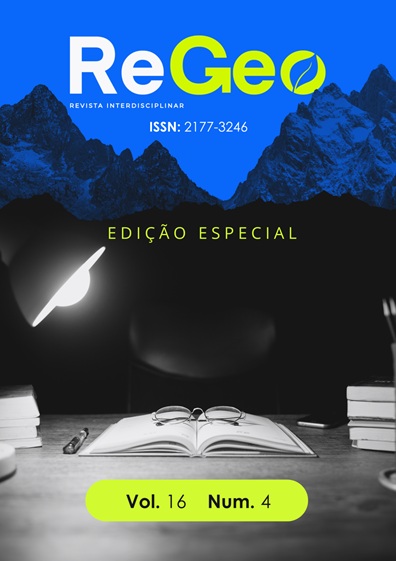EL ANIME Y LA REPRESENTACIÓN DEL ESPECTRO AUTISTA EN LOS MEDIOS: UN ANÁLISIS INTERPRETATIVO DEL PERSONAJE VIOLET EVERGARDEN
DOI:
https://doi.org/10.56238/revgeov16n4-081Keywords:
Neurodiversity, Autism Spectrum, Japanese Media, Symbolic Representation, Content AnalysisAbstract
This study focuses on analyzing the character Violet Evergarden, the protagonist of the anime of the same name, as a possible symbolic representation of traits associated with Autism Spectrum Disorder (ASD), even without the work explicitly assigning a diagnosis. The research question guiding the work is: To what extent can Violet Evergarden be interpreted as a neurodivergent figure, and what is the impact of this representation for viewers on the autism spectrum? The overall objective is to investigate how the narrative construction of the character expresses behaviors compatible with the Diagnostic and Statistical Manual of Mental Disorders (DSM-5) criteria for ASD. Specific objectives include: (a) identifying scenes from the anime that demonstrate difficulties with social interaction, emotional communication, and repetitive patterns; (b) relating these scenes to the clinical criteria for ASD; (c) discussing the symbolic impact of the character on neurodivergent viewers; and (d) reflecting on the role of Japanese media in representing atypical subjectivities. The methodology adopted is qualitative, exploratory, and interpretative, with content analysis according to Bardin (2011). Data collection and organization were based on the observation of key episodes of the series and the categorization of behaviors according to DSM-5 criteria. The methodological choices are supported by authors such as Minayo (2001), who emphasizes the value of qualitative research in interpreting social and cultural meanings. The results reveal that Violet displays traits such as literalness, cognitive rigidity, limited emotional communication, and hyperfocus on tasks—recurrent behaviors in neurodivergent profiles. The analysis also indicates that her trajectory has a significant impact on viewers with similar experiences, favoring processes of identification and subjective recognition. Thus, it is concluded that Violet Evergarden symbolically and sensitively represents aspects of neurodiversity in contemporary media.
Downloads
References
ALENCAR, H. F.; BARBOSA, H. F.; GOMES, R. V. B. Neurodiversidade: aspectos históricos, conceituais e impactos na educação escolar. In: CONGRESSO NACIONAL DE EDUCAÇÃO, 7., 2021, Anais... [S.l.]: Realize Editora, 2021. Disponível em: https://www.editorarealize.com.br/artigo/visualizar/75614.
AMERICAN PSYCHIATRIC ASSOCIATION. Manual diagnóstico e estatístico de transtornos mentais: DSM-5. 5. ed. Porto Alegre: Artmed, 2022.
ARAGÃO, G. F. (org.). Transtorno do espectro autista: abordagens multidisciplinares. São Paulo: Wak Editora, 2022.
ARMSTRONG, T. The power of neurodiversity: unleashing the advantages of your differently wired brain. [S.l.]: Da Capo Lifelong Books, 2011.
BARDIN, L. Análise de conteúdo. São Paulo: Edições 70, 2011.
BASTOS SANCHES, T. T.; TAVEIRA, L. S. Autismo: uma revisão bibliográfica. Caderno Intersaberes, [S.l.], v. 9, n. 18, 2020.
BLIACHERIS, M. W.; HERNANDEZ, A. Neurodiversidade como fenômeno psicopolítico. Revista Psicologia & Sociedade, [S.l.], 2024.
CHAPMAN, R. Empire of normality: neurodiversity and capitalism. [S.l.]: Pluto Press, 2023.
GARCIA, J.; BORGES, G. Competência midiática e cultura pop japonesa. Revista Estudos de Mídia, [S.l.], 2021.
LEMOS, E. L. M. D.; SALOMÃO, N. M. R.; AGRIPINO-RAMOS, C. S. Inclusão de crianças autistas: um estudo sobre interações sociais no contexto escolar. Revista Brasileira de Educação Especial, Marília, v. 20, n. 1, p. 117-130, jan./mar. 2014.
MARTINS, L. Violet Evergarden e o aprendizado da empatia e da autonomia. [S.l.], 2020. Disponível em: https://www.deviante.com.br/noticias/violet-evergarden-e-o-aprendizado-da-empatia-e-da-autonomia.
MINAYO, M. C. S. O desafio do conhecimento: pesquisa qualitativa em saúde. 14. ed. São Paulo: Hucitec, 2014.
NAZARENO, C. Mídia no Japão: como as comunicações do arquipélago sobrevivem à globalização e à internet. 1. ed. Brasília: FAC-UnB, 2020.
ORTEGA, F. O sujeito cerebral e o movimento da neurodiversidade. Mana, [S.l.], v. 14, n. 2, 2008.
ROSA, R. A.; BUCCO, E. A. Neurodiversidade: expandindo as fronteiras da diversidade, equidade e inclusão nas organizações. Cadernos EBAPE.BR, [S.l.], v. 23, n. 1, 2025. DOI: 10.1590/1679-395120230196.
SAITO, C. N. I. Cultura pop japonesa e os fenômenos otaku e hikikomori. Revista de Estudos Universitários, [S.l.], 2012.
SANTOS, A. N. A cultura otaku no Brasil: da obsessão a criação de um Japão imaginado. 2017. 233 f. Tese (Doutorado em Comunicação e Semiótica) - Pontifícia Universidade Católica de São Paulo, São Paulo, 2017. Disponível em: https://repositorio.pucsp.br.
SATO, C. Japop: o poder da cultura pop japonesa. São Paulo: Estação Liberdade, 2007.
SINGER, J. NeuroDiversity: the birth of an idea. [S.l.]: [s.n.], 2017.
TEIXEIRA, M. C. T. V. et al. Literatura científica brasileira sobre transtornos do espectro autista. Revista da Associação Médica Brasileira, [S.l.], v. 56, n. 5, 2010.
TONHEIRO, T. M. Importância da representação da neurodivergência na mídia. [S.l.], 2025. Disponível em: https://www.deviante.com.br/noticias/importancia-da-representacao-da-neurodivergencia-na-midia. Acesso em: 25 jun. 2025.
WALKER, N. Neuroqueer heresies: notes on the neurodiversity paradigm, autistic empowerment, and postnormal possibilities. [S.l.]: Autonomous Press, 2021.


